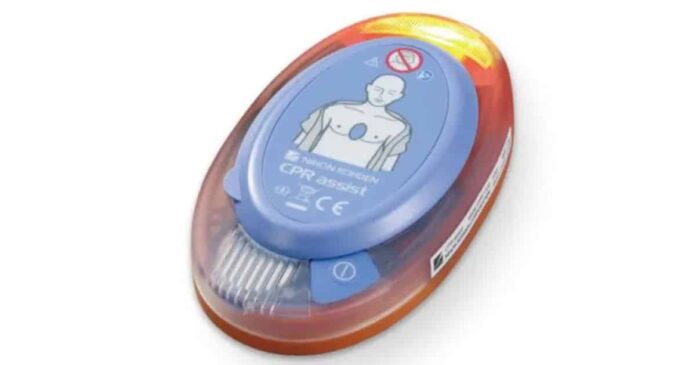If you’re curious as to what does a chest compression feedback device monitor is, you must read this article. You are on the correct page. We will instruct you on using the monitor for the chest compression feedback device. As is well known, many people experience cardiac arrest. Therefore, a chest compression feedback device monitor is an instrumented directive feedback device, also known as a CPR feedback tool, that delivers the rate, depth, and chest coil in real time.
Below, we’ll go into more detail about the monitor for the chest compression feedback device. So let’s begin by going over the list of content that is below:
What Does the Monitor for the Chest Compression Feedback Device Do?
A chest compression feedback device monitor, in its simplest form, is a tool that can be used to check the effectiveness of cardiopulmonary resuscitation (CPR). Monitoring the rate, level, depth, and chest recoil are all part of evaluating the quality of cardiopulmonary resuscitation (CPR). Rescuers can receive correction instructions from this device as well.
On the other hand, we leverage chest acceleration compression depth signals throughout the episode to provide input on depth and speed. This gadget also offers fundamental and significant data on chest compression fractions, such as the provider’s chest compressions duration.
By contrast, a CPR feedback device, also known as an instrumented directive feedback device, provides the student or healthcare provider with real-time input on the compression rate, depth, and chest recoil. The CPR feedback devices, however, may not require newborn or kid CPR.
Parts of the chest fraction
The following list includes the five crucial and essential elements of high-performance CP:
The chest compression fraction (CCF) is the first component, followed by the chest compression rate (CCR), the chest compression depth (CCD), the chest recoil (residual leaning), and the fifth and final component, ventilation.
The Lifesaving Art of CPR
In general, CPR is a technique for saving lives that keeps the blood and oxygen that always flow through our bodies after we cease breathing after we stop breathing. The chest compression feedback device, as usual, keeps an eye on the depth, rate, and quality of the CPR-based chest compressions.
CPR Monitor Components
CPR consists of four essential parts that work together to both quickly identify cardiac arrest and activate the emergency response system.
- Early CPR with a focus on chest compressions is the first element.
- Rapid defibrillation is the second element.
- Providing effective advanced life support is the third element.
- Integrated post-cardiac arrest treatment is the final element.
According to research:
The AHA guidelines for CPR and ECC research found that “inadequate performance of CPR is a common yet challenging for the healthcare providers and also the instructors to detect, thereby making it difficult to appropriately focus on the feedback and improve performance.” It provides the advantages of a CPR feedback tool. The usage of an aural feedback device, a metronome that generates acceptable compression rates, is shown in three primary trials.
Price of CPR Feedback Monitor
Without a doubt, CPR devices are readily available in a variety of price ranges. These devices are available at low, mid, and high prices. You can now decide if you want to buy a CPR feedback device for personal or professional use at an affordable, midrange, or high price.
Device for Personal CPR Feedback
Many free smartphone applications can offer real-time information, audio cues, and visual cues about the pace, depth, and quality of compression, so we recommend checking those out if you’re seeking to purchase a CPR feedback device for personal or professional use. However, hiring a website designer might be advantageous if you need a more customized and expert approach for your CPR feedback device. Their expertise enables them to create a specific website for you with cutting-edge features and a user-friendly interface.
The operation of compression feedback device monitors

A compression feedback device monitor is used in medicine to detect blood pressure and blood oxygen levels. It uses a sensor, a tiny device attached to the patient’s arm and linked to a computer, to detect the patient’s blood pressure and blood oxygen levels.
Data is subsequently transmitted from the monitor to the computer. The computer subsequently utilizes the information to make judgments and keep track of the patient’s health. Blood pressure and blood oxygen levels are measured using a medical instrument called a compression feedback device monitor.
It uses a sensor, a tiny device attached to the patient’s arm and linked to a computer, to detect the patient’s blood pressure and blood oxygen levels. Data is subsequently transmitted from the monitor to the computer. The computer subsequently utilizes the information to make judgments and keep track of the patient’s health.
What Does the Chest Compression Feedback Device Monitor Track?
This device tracks the following:
· Compressional Pressure
One of the most crucial metrics a chest compression feedback system can monitor is the depth of chest compressions. When used on an adult, the device may assess the chest compression depth and indicate whether it falls within the acceptable range of 2-2.4 inches (5-6 cm) or not. Shallower compressions may not produce enough blood flow, while deeper compressions may result in internal injuries or injury to the chest.
· Compression Rate
The compression rate, or the number of compressions conducted per minute, is another crucial metric that a chest compression feedback system can monitor. You should aim for between 100 and 120 compressions each minute. Device measurements of those rates can determine the optimality of compression rates. Too sluggish or too quick of a compression rate can result in inadequate filling of the heart chambers in between contractions.
· Position of the Hands
Only with the proper placement of the hands can chest compressions be effective. The hand should be placed in the center of the chest, between the nipples; if not, the chest compression feedback device will alert you. Inadequate hand placement during compressions can lead to insufficient pressure on the chest.
· Time Irregular
The “interrupted time” in cardiopulmonary resuscitation refers to the interval between chest compressions. When attempting to increase blood flow, any interruptions must be maintained to a minimum. The chest compression feedback device can monitor how frequently compressions are stopped and report that data to medical professionals, first responders, or bystanders to assist them in performing better.
· Ventilation
Giving the person in cardiac arrest rescue breaths, or ventilating, is an essential component of CPR. The chest compression feedback device can report the number of breaths delivered and the interval between breaths. Additionally, it can inform you of whether the breathing rate is appropriate in light of the patient’s age, size, and state of health.
· CPR resuscitation rate in percentage
The ratio of time spent conducting chest compressions to the overall amount spent performing CPR is known as the “CPR fraction.” The chest compression feedback device, which also offers information on compression time, can be used to monitor the CPR fraction.
Chest compression feedback device monitor alternatives
Despite the fact that chest compression feedback devices are an excellent tool to monitor how well chest compressions are performed during CPR, they might only be accessible in certain locations or circumstances. There are several ways to monitor chest compressions during CPR in various circumstances, including:
· Visual Reaction
Visual input can be seen in the chest rising and falling with each compression. Using this technique makes it possible to ensure that the compression and recoil are just correct. However, providing accurate information regarding the compression rate and the time at which it was halted could be necessary.
· Manual Inspection
Manual tracking during CPR entails gauging the patient’s pulse and other indicators of blood flow. This method may not provide feedback on the mechanics of chest compressions, but it can help assess how effectively CPR functions as a whole.
· Audio Reaction
An example of audio feedback is using a metronome or another sound generator to provide chest compressions with a consistent beat. This technique can assist in ensuring that the compression rate is between the recommended range of 100 and 120 compressions per minute.
· Simulation Instruction
During simulation training, CPR techniques are practiced on a manikin or computer. This can provide a realistic cardiac arrest simulation, allow medical personnel, first responders, or onlookers to practice CPR, and provide feedback on technique from trainers or instructors.
Frequently Asked Questions
Q. What is measured by a chest compression monitor?
When performing CPR, the chest pressure is monitored via a chest compression monitor. When the chest is crushed just enough to suggest that the compressions are effective, the monitor, which is worn by the person doing chest compressions, emits an audio signal.
Q. What is monitored by a test compression feedback device?
A test compression feedback device monitor is a machine that provides a feedback loop to evaluate how effectively a tire has been compressed. They are examined to make sure they are in good functioning order before being mounted on a wheel.
End Note:
We have explained what does a chest compression feedback monitor is and how it works. Compression Feedback Device Monitor is a tool that assists in tracking and measuring the effects of compression on the body. It is employed to evaluate and keep track of the body’s condition during physical exercise and recovery.
The tool can be utilized by patients or athletes and is used for both preventive and therapeutic reasons. It is a portable instrument that enables data collecting and is frequently worn on the wrist to gauge how compression affects the body. It can keep an eye on head, limb, and spinal compression. Blood pressure, pulse, and oxygen saturation rate are also measured.


